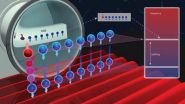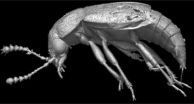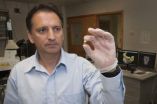(Press-News.org) Magnetic resonance imaging (MRI), which is the medical application of nuclear magnetic resonance spectroscopy, is a powerful diagnostic tool. MRI works by resonantly exciting hydrogen atoms and measuring the relaxation time -- different materials return to equilibrium at different rates; this is how contrast develops (i.e. between soft and hard tissue). By comparing the measurements to a known spectrum of relaxation times, medical professionals can determine whether the imaged tissue is muscle, bone, or even a cancerous growth. At its heart, MRI operates by quantum principles, and the underlying spectroscopic techniques translate to other quantum systems.
Recently physicists at the Joint Quantum Institute* led by JQI Fellow Christopher Monroe have executed an MRI-like diagnostic on a crystal of interacting quantum spins. The technique reveals many features of their system, such as the spin-spin interaction strengths and the energies of various spin configurations. The protocol was published recently in the journal Science (DOI:10.1126/science.1251422). Previously, such methods existed for an array of only three spins--here, the JQI team performed proof-of-principle experiments with up to 18 spins. They predict that their method is scalable and may be useful for validating experiments with much larger ensembles of interacting spins.
'Spin' models are a vital mathematical representation of numerous physical phenomena including magnetism. Here, the team implements an Ising spin model, which has two central features. The spins themselves have only two options for orientation ("up" or "down"), and the interactions happen between pairs of spins, much like the interaction between bar magnets. The Ising model can be generalized to many seemingly disparate systems where there are binary choices. For instance, this model was used to study how ideas spread through social networks. In this application, spin-spin interactions represented connections between people in a network, analogous to interaction energies between magnetic spins. Here, the extent of the human connection affected how opinions spread through a social network population.
Back in the quantum laboratory, physicists have the ability to precisely study and calculate everything about a single or a small collection of essentially "textbook" spin particles within various physical platforms. Yet gaining a complete understanding of the behavior of many interacting spins is a daunting task, for both experimentalists and theorists. Ion traps are a leader in experimental studies of quantum physics, and thus well-poised for tackling this challenge.
The sheer numbers involved in large spin systems give insight into the difficulty of studying them. Consider that for N number of particles there are N(N-1)/2 two-body interactions. The interactions give rise to an energy spectrum containing 2N individual spin configurations. Here, the team does a complete analysis with 5 spins, and so there are 10 two-body interactions and 32 different spin chain configurations. Conventional computers can work with these modest numbers, but for as few as 30 spins the number of states pushes past a billion, which begins to be prohibitively complicated, particularly when the 435 separate interactions are all distinct. Physicists hope that quantum simulators can help bridge this gap.
The Ion Trap Quantum Spin Simulator
Quantum Simulation is a term that broadly describes the use of one controllable quantum system to study a second analogous, but less experimentally feasible quantum phenomenon. A full-scale quantum computer does not yet exist and classical computers often cannot solve large-scale quantum problems, thus a "quantum simulator" presents an attractive alternative for gaining insight into complex problems.
In the experiment described here, laser-cooled ytterbium atoms confined inside an ion trap are configured to simulate an array of spins. Each spin is made from two of the ion's internal energy levels that are separated by a microwave frequency of 12.642819 GHz (billion vibrations/second). When radiation having this frequency interacts with the ion, its spin flip-flops between the two spin states, "up" and "down".
The ions also have a vibrational frequency determined by the trap that confines them--typically around 1 MHz or 1 million vibrations/second. In the quantum regime, the quanta of vibration called a phonon can be controllably added and removed from the system with precisely controlled external laser forces. These phonons act as communication channels for the spins, and when combined with the gigahertz radiation, are used to generate a rich variety of interactions.
The simulation begins with the spins initialized into a well-known spin configuration (e.g. all of the spins in the "up" configuration). Then, the physicists apply a probe, which is a tiny oscillating electromagnetic field generated from the laser. They scan this probe to find the special "resonant" frequencies that cause the spin crystal to undergo transitions to different configurations (see Figure 1 in gallery). This energy/frequency is directly related to how the spins are interacting with each other. If the spins are interacting weakly, with only their nearest neighbors, then the transition energy will be different than when the interactions are more extended. To assemble a complete energy spectrum and measure all configurations the team must repeatedly probe the ion spins over a range of frequencies. A crucial component of this protocol is the imaging system, which allows the team to directly measure each individual ion spin in the crystal for every probe frequency.
The JQI team hopes this new tool will ease the way towards simulating larger systems and possibly other spin models. Says Crystal Senko, JQI graduate student and lead author of this work, "Quantum simulation experiments will eventually be studying physics questions that can't be answered in any other way, so we might not know how to tell if the experiment isn't doing quite what we expected. That means it will be important to have many diagnostics, so that when we see something strange and interesting we can be confident that it's interesting physics instead of just a bug in the experiment."
Significantly, this protocol is not limited to trapped ions, and can be tailored to different simulation platforms. Just as MRI is an indispensable tool in modern medicine, this new verification technique may prove essential to the realm of quantum simulation.
INFORMATION:
*This research was performed at JQI in the group of Christopher Monroe, in collaboration with JQI Alum and UCLA Professor, Wes Campbell.
Spin diagnostics
MRI for a quantum simulation
2014-07-31
ELSE PRESS RELEASES FROM THIS DATE:
Pressure probing potential photoelectronic manufacturing compound
2014-07-31
Washington, D.C.— Molybdenum disulfide is a compound often used in dry lubricants and in petroleum refining. Its semiconducting ability and similarity to the carbon-based graphene makes molybdenum disulfide of interest to scientists as a possible candidate for use in the manufacture of electronics, particularly photoelectronics.
New work from a team including several Carnegie scientists reveals that molybdenum disulfide becomes metallic under intense pressure. It is published in Physical Review Letters.
Molybdenum disulfide crystalizes in a layered structure, with ...
Oldest rove beetle in the Omaliini tribe found in French amber
2014-07-31
An international team of scientists from Spain, France, and the U.S. has discovered and described a rove beetle that is the oldest definitive member of the tribe Omaliini that has ever been found in amber. The discovery and description were made possible through the use of the propagation phase-contrast X-ray synchrotron imaging technique, which allows the detailed study of otherwise invisible specimens in opaque amber. The new species is described in the journal Annals of the Entomological Society of America in an article called "Oldest Omaliini (Coleoptera: Staphylinidae: ...
Free pores for molecule transport
2014-07-31
This news release is available in German.
Metal-organic frameworks (MOFs) can take up gases similar to a sponge that soaks up liquids. Hence, these highly porous materials are suited for storing hydrogen or greenhouse gases. However, loading of many MOFs is inhibited by barriers. Scien-tists of Karlsruhe Institute of Technology (KIT) now report in Nature Communications that the barriers are caused by cor-rosion of the MOF surface. This can be prevented by water-free synthesis and storing strategies.
MOFs are crystalline materials consisting of metallic nodes ...
Scientists shine bright new light on how living things capture energy from the sun
2014-07-31
Since Alexandre Edmond Becquerel first discovered the photovoltaic effect in 1839, humankind has sought to further understand and harness the power of sunlight for its own purposes. In a new research report published in the August 2014 issue of the FASEB Journal, scientists may have uncovered a new method of exploiting the power of sunlight by focusing on a naturally occurring combination of lipids that have been strikingly conserved throughout evolution. This conservation—or persistence over time and across species—suggests that this specific natural combination of lipids ...
Misinformation diffusing online
2014-07-31
The spread of misinformation through online social networks is becoming an increasingly worrying problem. Researchers in India have now modeled how such fictions and diffuse through those networks. They described details of their research and the taxonomy that could help those who run, regulate and use online social networks better understand how to slow or even prevent the spread of misinformation to the wider public.
Krishna Kumar and G. Geethakumari of the Department of Computer Science and Information Systems, at BITS-Pilani, Hyderabad Campus, in Andhra Pradesh, India, ...
Lead in teeth can tell a body's tale, UF study finds
2014-07-31
GAINESVILLE, Fla. – Your teeth can tell stories about you, and not just that you always forget to floss.
A study led by University of Florida geology researcher George D. Kamenov showed that trace amounts of lead in modern and historical human teeth can give clues about where they came from. The paper will be published in the August issue of Science of The Total Environment.
The discovery could help police solve cold cases, Kamenov said. For instance, if an unidentified decomposed body is found, testing the lead in the teeth could immediately help focus the investigation ...
Scientists discover biochemical mechanisms contributing to fibromuscular dysplasia
2014-07-31
An important step has been made to help better identify and treat those with fibromuscular dysplasia (FMD). FMD causes both an abnormal narrowing and enlarging of medium sized arteries in the body, which can restrict blood flow to the kidneys and other organs causing damage. In a new report appearing in August 2014 issue of The FASEB Journal, scientists provide evidence that that FMD may not be limited to the arteries as currently believed. In addition, they show a connection to abnormalities of bones and joints, as well as evidence that inflammation may be driving the ...
New paper describes how DNA avoids damage from UV light
2014-07-31
BOZEMAN, Mont. – In the same week that the U.S. surgeon general issued a 101-page report about the dangers of skin cancer, researchers at Montana State University published a paper breaking new ground on how DNA – the genetic code in every cell – responds when exposed to ultraviolet (UV) light.
The findings advance fundamental understanding of DNA damage by the UV rays found in sunlight. This damage can lead to skin cancer, aging and some degenerative eye diseases.
"Our paper advances foundational knowledge about how DNA responds to UV radiation. In our experiments, ...
Magnetic resonance imaging in patients with transient ischemic attack
2014-07-31
Transient ischemic attack (TIA) is a temporary event, which portends a higher risk of a disabling stroke following the TIA. However, the evaluation and management of TIA vary worldwide and is debated and controversial. Dr. Mohamed Al-Khaled from University of Lübeck in Germany considered With the development of brain imaging, particularly diffusion weighted imaging-magnetic resonance imaging (DWI-MRI), the diagnosis of TIA changed from time-based definition to a tissue-based one. DWI-MRI became a mandatory tool in the TIA workup. The DWI-MRI provides not only the evidence ...
Ligaments disruption: A new perspective in the prognosis of SCI
2014-07-31
Worldwide prevalence of Spinal Cord Injury (SCI) is ranging from 233 to 755 per million inhabitants, whereas reported incidence lies between 10.4 and 83 per million inhabitants per year. Thus, the socioeconomic impact of SCI associated with cervical trauma is high enough to be encountered within one of the most important worries in vast majority of developed countries.
The ability to predict recovery following SCI is of paramount importance to the physician's role in providing the best care and guidance to patients and families during the illness. Diagnosis of cervical ...
LAST 30 PRESS RELEASES:
Korea University study mimics heart mechanics in organoids using three-dimensional magnetic torque
Catching a radical in motion with µSR spectroscopy
Hanbat National University researchers reveal smart transparent woods that block UV and save energy
Rhythm contains important information for the cell
Nitrogen is key to faster regrowth in deforested areas, say researchers
Recovering tropical forests grow back nearly twice as fast with nitrogen
A new diet option for mild-to-moderate Crohn’s disease
Electric vehicles could catch on in Africa sooner than expected
New test could help pinpoint IBD diagnosis, study finds
Common eye ointment can damage glaucoma implants, study warns
ACCESS-AD: a new European initiative to accelerate timely and equitable AD diagnosis, treatment and care
Mercury exposure in northern communities linked to eating waterfowl
New Zealand researchers identify brain link to high blood pressure
New research confirms people with ME/CFS have a consistent faulty cellular structure
Hidden cancer risk behind fatty liver disease targets
Born in brightness, leading to darkness
Boron-containing Z-type and bilayer benzoxene
Hong Kong researchers break the single-field barrier with dual-field assisted diamond cutting
Work hard, play hard?
Wood becomes smart glass: Photo- and electro-chromic membrane switches tint in seconds
The Lancet: COVID-19 vaccine hesitancy decreased over time, though mistrust persists among certain groups, study of over 1 million people in England suggests
Psychosis patients ‘living in metaphor’ -- new study radically shifts ideas about delusions
Clinical trial in Ethiopia targets the trachoma scourge
Open-sourcing the future of food
Changes in genetic structure of yeast lead to disease-causing genomic instabilities
UC San Diego Health Sciences Grant Writing Course helps launch successful research careers
Study: Many head and neck cancer trials end early. Why?
Tufts vice provost for research named Foreign Fellow of Indian National Science Academy
New model improves prediction of prostate cancer death risk
Two wrongs make a right: how two damaging variants can restore health
[Press-News.org] Spin diagnosticsMRI for a quantum simulation



